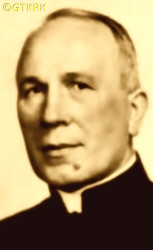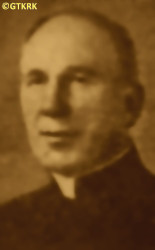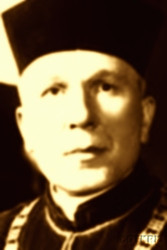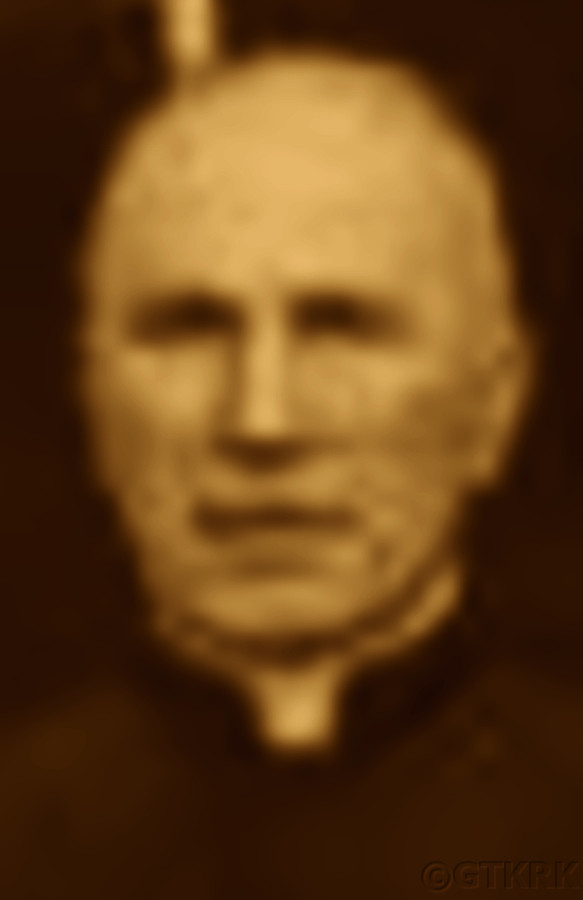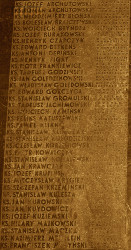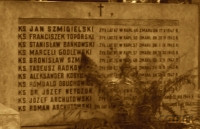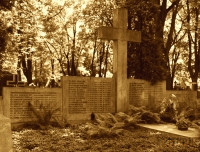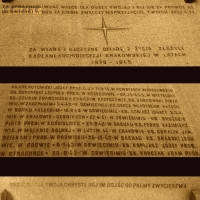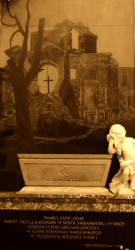Roman Catholic
St Sigismund parish
05-507 Słomczyn
85 Wiślana Str.
Konstancin deanery
Warsaw archdiocese, Poland
full list:
displayClick to display full list

searchClick to search full list by categories
wyświetlKliknij by wyświetlić pełną listę po polsku

szukajKliknij by przeszukać listę wg kategorii po polsku

Martyrology of the clergy — Poland
XX century (1914 – 1989)
personal data
surname
ARCHUTOWSKI
forename(s)
Joseph (pl. Józef)
function
diocesan priest
creed
Latin (Roman Catholic) Church RCmore on
en.wikipedia.org
[access: 2014.09.21]
diocese / province
Warsaw archdiocesemore on
en.wikipedia.org
[access: 2013.05.19]
academic distinctions
Sacred Theology MA
honorary titles
Minor Canonmore on
en.wikipedia.org
[access: 2014.11.14]
(1943 – , St John the Baptist Martyrdom RC archcathedral church, Warsawtoday: Warsaw city pov., Masovia voiv., Poland
more on
en.wikipedia.org
[access: 2021.10.09])
honorary canonmore on
en.wikipedia.org
[access: 2014.11.14]
(1943 – , St John the Baptist Martyrdom RC archcathedral church, Warsawtoday: Warsaw city pov., Masovia voiv., Poland
more on
en.wikipedia.org
[access: 2021.10.09], St John the Baptist Martyrdom RC archcathedral church, Warsawtoday: Warsaw city pov., Masovia voiv., Poland
more on
en.wikipedia.org
[access: 2021.10.09])
„Polonia Restituta” Cross — 3rd Class, Commander'smore on
en.wikipedia.org
[access: 2019.04.16]
(10.11.1938)
„For Long Service” medal — silvermore on
en.wikipedia.org
[access: 2020.05.25]
(1938)
„For Long Service” medal — bronzemore on
en.wikipedia.org
[access: 2020.05.25]
(1938)
date and place
of death
31.08.1944

Warsawtoday: Warsaw city pov., Masovia voiv., Poland
more on
en.wikipedia.org
[access: 2021.10.09]
details of death
After German and Russian invasion of Poland in 09.1939 and start of the World War II, after start of German occupation arrested on 06.11.1939 by the Germans, during German „Sonderaktion Krakau”, Polish intelligence in Kraków extermination action.
Jailed in Montelupich Str. prison in Kraków.
Next transported to Wrocław prison and from there to KL Sachsenhausen concentration camp.
On 08.12.1940 released — — returned to Kraków, then the capital of the Germ. Generalgouvernement, the German–occupied territory of central Poland.
Run clandestine lectures in Kraków (part of educational activitities of the Polish Clandestine State) — in Salvatorian Fathers' monastery.
In 05.1943 moved to Warsaw.
Lectured on clandestine Catholic Theology Department of Warsaw University (part of Polish Clandestine State).
Perished during Warsaw Uprising 08‐10.1944, under the rubble of the bombed out by the Germans St Casimir church in Warsaw, along with 3 other priests, 34 nuns and over 1,000 civilians.
The church and its basement were transformed during the Uprising into a field hospital, run by the Medical Office of the Warsaw District of the Home Army AK (part of Polish Clandestine State) codename „Bakcyl”, part of the AK „North” Group. The area of the Old Town where the church is located had been under siege by the Germans for about two weeks.
On the night of 30‐31.08.1944, the insurgents made an unsuccessful attempt to break through to the Śródmieście district — it was the bloodiest battle during the Uprising. In retaliation, the Germans carried out particularly heavy bombings of the Old Town, including St Casimir church.
cause of death
shelling (bombardment)
perpetrators
Germans
sites and events
Warsaw (St Casimir church)Click to display the description, Warsaw UprisingClick to display the description, Secret educational systemClick to display the description, KL SachsenhausenClick to display the description, Cracow (Montelupich)Click to display the description, Sonderaktion KrakauClick to display the description, «Intelligenzaktion»Click to display the description, GeneralgouvernementClick to display the description, Ribbentrop‐MolotovClick to display the description, Pius XI's encyclicalsClick to display the description
date and place
of birth
01.11.1879Birth certification on:
metryki.genealodzy.pl
[access: 2025.03.07]

Karolinotoday: Serock gm., Legionowo pov., Masovia voiv., Poland
more on
en.wikipedia.org
[access: 2022.01.28]
parents
ARCHUTOWSKI Theophilus Felix
🞲 1842, Zalesie Borowetoday: Serock gm., Legionowo pov., Masovia voiv., Poland
more on
en.wikipedia.org
[access: 2025.02.23] — 🕆 16.08.1915, Gzowotoday: Pokrzywnica gm., Pułtusk pov., Masovia voiv., Poland
more on
en.wikipedia.org
[access: 2025.02.22]

KARWOWSKA Emily
🞲 1853, Karolinotoday: Serock gm., Legionowo pov., Masovia voiv., Poland
more on
en.wikipedia.org
[access: 2022.01.28] — 🕆 27.09.1918, Gzowotoday: Pokrzywnica gm., Pułtusk pov., Masovia voiv., Poland
more on
en.wikipedia.org
[access: 2025.02.22]
baptism
16.11.1879Birth certification on:
metryki.genealodzy.pl
[access: 2025.03.07]

Zegrzetoday: Serock gm., Legionowo pov., Masovia voiv., Poland
more on
pl.wikipedia.org
[access: 2021.12.19]
St Anthony of Padua, St Barbara and St Rock RC church
presbyter (holy orders)
ordination
1904

Sankt Petersburgtoday: Saint Petersburg city, Russia
more on
en.wikipedia.org
[access: 2020.07.31]
St Catherine of Alexandria RC churchmore on
en.wikipedia.org
[access: 2022.01.06]
positions held
1943 – 1944
parish priest — Warsawtoday: Warsaw city pov., Masovia voiv., Poland
more on
en.wikipedia.org
[access: 2021.10.09] ⋄ Visitation of the Blessed Virgin Mary RC parish ⋄ Warsaw‐in‐urbedeanery name
today: Warsaw city pov., Masovia voiv., Poland RC deanery
1943 – 1944
Minor Canon — Warsawtoday: Warsaw city pov., Masovia voiv., Poland
more on
en.wikipedia.org
[access: 2021.10.09] ⋄ Cathedral Chapter ⋄ St John the Baptist RC archcathedral church
1943 – 1944
lecturer — Warsawtoday: Warsaw city pov., Masovia voiv., Poland
more on
en.wikipedia.org
[access: 2021.10.09] ⋄ Department of Catholic Theology, University of Warsaw [i.e. University of Warsaw (from 1945) / clandestine University (1939‐1945) / Joseph Piłsudski University (1935‐1939) / University of Warsaw (1915‐1935) / Imperial University of Warsaw (1870‐1915)]
1923 – 1939
full professor — Krakówtoday: Kraków city pov., Lesser Poland voiv., Poland
more on
en.wikipedia.org
[access: 2021.06.07] ⋄ Old Testament Biblical Sectioni, Jagiellonian University UJ — lecturer in i.a. the Holy Scriptures of the Old Testament, Hebrew language and history of religion
1937 – 1939
publisher — „Biblical Review”
till 1933
dean — Krakówtoday: Kraków city pov., Lesser Poland voiv., Poland
more on
en.wikipedia.org
[access: 2021.06.07] ⋄ Department of Theology, Jagiellonian University UJ — position held in 1924‐1925, 1926‐1927, 1931‐1933
1920 – 1923
supernumerary professor — Krakówtoday: Kraków city pov., Lesser Poland voiv., Poland
more on
en.wikipedia.org
[access: 2021.06.07] ⋄ Old Testament Biblical Sectioni, Jagiellonian University UJ — lecturer in i.a. the Holy Scriptures of the Old Testament, Hebrew language and history of religion
1919 – 1920
deputy professor — Lublintoday: Lublin city pov., Lublin voiv., Poland
more on
en.wikipedia.org
[access: 2021.08.20] ⋄ Bible Study, Catholic University of Lublin KUL [i.e. Catholic University of Lublin KUL (since 1928) / clandestine Catholic University of Lublin KUL (1939‐1944) / University of Lublin (1918‐1928)] — lecturer in the Holy Scriptures of the Old Testament, Hebrew language (including Semitic linguistics issues) and history of religion
1908 – 1919
prefect — Warsawtoday: Warsaw city pov., Masovia voiv., Poland
more on
en.wikipedia.org
[access: 2021.10.09] ⋄ Trade School of the Assembly of Merchants of the City of Warsaw ⋄ RC parish — also: student of summer lectures in the field of biblical studies at the universities in Wrocław, Leipzig, Munich, Würzburg and Fribourg in Switzerland, and author of several dozen publications on biblical topics and the history of religion
1907 – 1908
vicar — Łowicztoday: Łowicz urban gm., Łowicz pov., Łódź voiv., Poland
more on
en.wikipedia.org
[access: 2021.12.18] ⋄ Assumption of the Blessed Virgin Mary and St Nicholas the Bishop and Confessor RC collegiate parish ⋄ Łowicztoday: Łowicz urban gm., Łowicz pov., Łódź voiv., Poland
more on
en.wikipedia.org
[access: 2021.12.18] RC deanery — also: prefect at 7–grade men's Polish School of Commerce
till 1907
vicar — Warsawtoday: Warsaw city pov., Masovia voiv., Poland
more on
en.wikipedia.org
[access: 2021.10.09] ⋄ RC parish — also: prefect of elementary schools
vicar — Zgierztoday: Zgierz urban gm., Zgierz pov., Łódź voiv., Poland
more on
en.wikipedia.org
[access: 2021.12.18] ⋄ St Catherine of Alexandria the Virgin and Martyr RC parish ⋄ Łódźtoday: Łódź city pov., Łódź voiv., Poland
more on
en.wikipedia.org
[access: 2021.07.18] RC deanery — also: prefect of elementary schools
1905 – c. 1906
vicar — Skierniewicetoday: Skierniewice city pov., Łódź voiv., Poland
more on
en.wikipedia.org
[access: 2021.12.18] ⋄ St James the Apostle RC parish ⋄ Skierniewicetoday: Skierniewice city pov., Łódź voiv., Poland
more on
en.wikipedia.org
[access: 2021.12.18] RC deanery — also: prefect of elementary schools
1901 – 1905
student — Sankt Petersburgtoday: Saint Petersburg city, Russia
more on
en.wikipedia.org
[access: 2020.07.31] ⋄ philosophy and theology, Imperial Roman Catholic Spiritual Academy (1842‐1918) — postgraduate specialised studies, crowned in 1904 with the title of candidate of theology, and in 1905 with the title of master of sacred theology, based on the dissertation Lat. „Doctrina Veteris Testamenti de sapientia” (Eng. „The teaching of the Old Testament on wisdom”)
1898 – 1901
student — Warsawtoday: Warsaw city pov., Masovia voiv., Poland
more on
en.wikipedia.org
[access: 2021.10.09] ⋄ philosophy and theology, Metropolitan Theological Seminary
author of academic textbooks, i.a. „History and criticism of the Hebrew text of the Old Testament” (Kraków, 1938), „On the inspiration of the Holy Scriptures” (Kraków, 1930), „Detailed introduction to the Holy Books of the Old Testament” (Kraków, 1927), „Grammar of the Hebrew language” (Warsaw, 1908)
others related
in death
BAREJKAClick to display biography Catherine (Sr Mary Gertrude of the Holiest Heart of Jesus), BORKEMClick to display biography Louise (Sr Mary Antonina of the Holy Ghost), HRYNASZKIEWICZClick to display biography Leonard Victor, KARCZClick to display biography Hedwig Magdalene (Sr Mary Joachima of the Blessed Sacrament), KARCZEWSKAClick to display biography Sophia (Sr Mary Rose of the Blessed Sacrament), KILAŃSKAClick to display biography Catherine (Sr Mary Benita of the Holiest Heart of Jesus), KOPERSKAClick to display biography Apolonia Eleonor (Sr Mary Thomae of the Holy Trinity), KOWALSKAClick to display biography Victoria (Sr Mary Anne of the St Joseph's Protection), KRAKÓWClick to display biography Irene (Sr Hillary), KUŹMIŃSKAClick to display biography Margaret (Sr Mary Catherine of the All Saints), MARCZUKClick to display biography Helen (Sr Mary Bernarda of the Holiest Family), MATUSZCZAKClick to display biography Mary (Sr Mary Anselma of Immaculate Conception of the Blessed Virgin Mary), MAZERSKIClick to display biography John, MIĘTKOWSKAClick to display biography Mary (Sr Mary Cecilia of the Blessed Sacrament), NARUKClick to display biography Mary (Sr Mary Elisabeth of the Mother of God), OLĘDZKAClick to display biography Janet (Sr Mary Josefa of Immaculate Conception of the Blessed Virgin Mary), POGONOWSKAClick to display biography Irene Casimira (Sr Mary Vladislava of the Holiest Wounds of the Lord Jesus), POLAKOWSKAClick to display biography Marianne (Sr Mary Flavia of the Cross), PRZEMYSKAClick to display biography Angela (Sr Mary Stanislava of Divine Mercy), PRZYKOPClick to display biography Janet, PUCHAŁAClick to display biography Genevieve (Sr Mary Hedwig of the Blessed Sacrament), REJEWSKAClick to display biography Stephanie Wanda (Sr Mary Ignatia of the Lamb of God), ROZWADOWSKIClick to display biography Michael, RUDNICKAClick to display biography Caroline (Sr Mary Clementine of the Holiest Heart of Jesus), SCHMITZ de GROLLENBOURGClick to display biography Mary Josefa (Sr Mary Magdalene of the St Joseph's Protection), SIWEKClick to display biography Francesca (Sr Barbara), SŁOWACKAClick to display biography Sophia Catherine (Sr Mary Andrea of the Nativity of the Blessed Virgin Mary), SZKIŁĄDŹClick to display biography Casimira (Sr Mary Modeste of the Cross), TOKARSKAClick to display biography Janet Bronislava (Sr Mary Agnes of Jesus), TOMASZEWSKAClick to display biography Aurelia (Sr Mary Therese of Jesus), TRYCClick to display biography Josefa (Sr Mary Aloysia of St Benedict), TURAKClick to display biography Rosalie (Sr Mary Ceslava of the St Joseph's Protection), ZALAZEKClick to display biography Josefa Marianne (Sr Mary Margaret of the Holiest Heart of Jesus), ZALEWSKAClick to display biography Laurence Laurentia (Sr Mary Augustina of the Blessed Sacrament), ZAŁUSKAClick to display biography Sophia Apolonia (Sr Mary Innocente of the Cross), ZDROJEWSKAClick to display biography Marianne (Sr Mary Claire of the Blessed Sacrament)
sites and events
descriptions
Warsaw (St Casimir church): On 31.08.1944 during Warsaw Uprising Germans run a bombing raid on St Casimir church at 2 Rynek Nowego Miasta (Old Town region), one of the most precious Baroque buildings in Poland, still under insurgents control. The bombs pierced through the basement ceiling that caved in. In the church Benedictine Nuns of Perpetual Adoration run a field hospital run to Medical Service of Warsaw District of Home Army AK (part of Polish Clandestine State) codename „Bakcyl” — in the AK „North” Group. Under rubble c. 1,000 civilians (mainly wounded patients), 4 Catholic priests and 34 nuns perished (one other nun died a few days later from exhaustion), as well as a few dozen Jews who survived Warsaw ghetto and went into hiding. The monastery and church complex were laid in ruins (destruction was estimated at 80‐90%). (more on: www.benedyktynki-sakramentki.orgClick to attempt to display webpage
[access: 2014.10.04])
Warsaw Uprising: Lasted from 01.08.1944 till 03.10.1944. Was an attempt to liberate Polish capital from occupying Germans by the Polish Clandestine State — a unique in the history of the world political structure on the territories occupied by the Germans, effectively governing clandestinely in Poland — and by fighting on its behalf underground military units, mainly of Home Army (former Armed Struggle Association ZWZ) and National Armed Forced (NSZ). At the same time Russians stopped on purpose the offensive on all front, halted on the other bank of Vistula river and watched calmly the annihilation of the city, refusing even the mid‐landing rights to the Allied planes carrying weapons and supplies to the insurgents from Italy. During the Uprising Germans murdered approx. 200,000 Poles, mainly civilians. Approx. 200 priests and nuns died in fighting or were murdered by the Germans, many in mass executions. (more on: en.wikipedia.orgClick to attempt to display webpage
[access: 2013.08.17])
Secret educational system: After the occupation began, the Germans started a ruthless fight against the Polish intelligentsia. The memorial issued on the basis of the guidelines of the German socialist leader, Adolf Hitler, was in force. It stated that in the occupied Polish territories: „Universities and other higher education institutions, vocational schools and secondary schools have always been centers of Polish chauvinistic upbringing and therefore should be closed altogether. Only elementary schools should be allowed, which should teach only the most primitive things: arithmetic, reading and writing. Education in nationally important subjects, such as geography, history, the history of literature, and gymnastics, must be banned”. Even religious education higher than elementary has become illegal. And in areas directly incorporated to Germany, e.g. Germ. Reichsgau Wartheland, the Germans went further — shut down all schools teaching in Polish, Hebrew and Yiddish. The resistance Polish Clandestine State created a secret education system. In 1944, over 100,000 young people studied in secret high schools, and several thousand in secret universities (e.g. the University of Warsaw, the University of Western Territories, the Jagiellonian University, the John Casimir University in Lviv. Secret teaching was ruthlessly combated by the German occupation authorities ‐ in 1939‐ 1945 8,500 Polish teachers lost their lives. (more on: en.wikipedia.orgClick to attempt to display webpage
[access: 2022.11.29])
KL Sachsenhausen: In Germ. Konzentrationslager (Eng. concentration camp) KL Sachsenhausen, set up in the former Olympic village in 07.1936, hundreds of Polish priests were held in 1940, before being transported to KL Dachau. Some of them perished in KL Sachsenhausen. Murderous medical experiments on prisoners were carried out in the camp. In 1942‐1944 c. 140 prisoners slaved at manufacturing false British pounds, passports, visas, stamps and other documents. Other prisoners also had to do slave work, for Heinkel aircraft manufacturer, AEG and Siemens among others. On average c. 50,000 prisoners were held at any time. Altogether more than 200,000 inmates were in jailed in KL Sachsenhausen and its branched, out of which tens of thousands perished. Prior to Russian arrival mass evacuation was ordered by the Germans and c. 80,000 prisoners were marched west in so‐called „death marches” to other camps, i.e. KL Mauthausen‐Gusen and KL Bergen‐Belsen. The camp got liberated on 22.04.1945. After end of armed hostilities Germans set up there secret camp for German prisoners and „suspicious” Russian soldiers. (more on: en.wikipedia.orgClick to attempt to display webpage
[access: 2018.11.18])
Cracow (Montelupich): Cracow penal prison, during occupation run by the Germans — from 28.02.1941 by Germ. Geheime Staatspolizei (Eng. Secret State Police, known as Gestapo. In 1940‐1944 Germans jailed there approx. 50,000 prisoners, mainly Poles and Jews. Some of them were transported to KL Auschwitz concentration camp, some were executed. After cease in war effort the prison was used by UB — a Polish unit of Russian NKVD — as a prison for Polish independence resistance fighters, some of which were subsequently sent to prisons and slave labour camps in Russia. (more on: en.wikipedia.orgClick to attempt to display webpage
[access: 2014.10.31])
Sonderaktion Krakau: German operation against Cracow intelligentsia, part of a broader «Intelligenzaktion» against Polish intelligentsia, carried out in 1939‐1940. On 06.11.1939 Germans arrested 183/4 Cracow professors from prestigiuous universities, mainly Jagiellonian University. They were jailed in Montelupich prison in Cracow prior to being sent to KL Sachsenhausen concentration camp. 4 days later on 10.11.1939 Germans arrested 25 Jesuits from Cracow College. They were also jailed in Montelupich prison and then transported to German concentration camps where 7 of them perished. (more on: en.wikipedia.orgClick to attempt to display webpage
[access: 2015.03.01])
«Intelligenzaktion»: German: «Intelligenzaktion» (English: „Intelligence Action”) — a German program of extermination of the Polish elite, mainly the intelligentsia and leadership layers, carried out from the beginning of the occupation in w 09.1939 to 04.1940, mainly in territories directly annexed to Germany, but also in the so‐called Germ. Generalgouvernement (Eng. General Governorate), where it was called «AB‐aktion». In the first phase, immediately after the beginning of the German occupation, during military operations carried out by the Germ. Wehrmacht (Eng. Armed Forces) and the genocidal units of the Germ. Einsatzgruppen (Eng. Operational Groups) of the Germ. Sicherheitspolizei (Eng. Security Police), i.e. SiPo, and Germ. Sicherheitsdienst des Reichsführers SS (Eng. Security Service of the Reichsführer SS), i.e. SD, organized by the Germ. Reichssicherheitshauptamt (Eng. Reich Main Security Office), i.e. RSHA, which followed the troops, carried out under the Germ. Unternehmen „Tannenberg” (Eng. Operation „Tannenberg”) — based on the so‐called Germ. Sonderfahndungsliste (Eng. Special Wanted Lists), i.e. proscription lists of Poles considered particularly dangerous to the Third Reich, prepared by the Zentralstelle II/P (Polen) unit of the German RSHA. Later, implemented by the German civilian occupation authorities and the genocidal unit of the Germ. Volksdeutscher Selbstschutz (Eng. Ethnic Germans Self‐Defense), whose members were Germ. Volksdeutsche (Eng. Ethnic Germans), i.e. representatives of the German minority in Poland. According to various sources, these lists, at the beginning of 09.1939, could have contained the details of 61,000—88,000 „dangerous” Poles — although these figures cannot be confirmed. In total, during this genocide, c. 50,000 teachers, Catholic priests, representatives of the landed gentry, freelancers, social and political activists, and retired military personnel were systematically and methodically murdered. Another 50,000 were sent to concentration camps, where only a negligible percentage survived. (more on: en.wikipedia.orgClick to attempt to display webpage
[access: 2014.10.04])
Generalgouvernement: After the Polish defeat in the 09.1939 campaign, which was the result of the Ribbentrop‐Molotov Pact and constituted the first stage of World War II, and the beginning of German occupation in part of Poland (in the other, eastern part of Poland, the Russian occupation began), the Germans divided the occupied Polish territory into five main regions. In two of them new German provinces were created, two other were incorporated into other provinces. However, the fifth part was treated separately, and in a political sense it was supposed to recreate the German idea from 1915 (during World War I, after the defeat of the Russians in the Battle of Gorlice in 05.1915) of creating a Polish enclave within Germany. Illegal in the sense of international law, i.e. Hague Convention, and public law, managed by the Germans according to separate laws — especially established for the Polish Germ. Untermenschen (Eng. subhumans) — till the Russian offensive in 1945 it constituted part of the Germ. Großdeutschland (Eng. Greater Germany). Till 31.07.1940 formally called Germ. Generalgouvernement für die besetzten polnischen Gebiete (Eng. General Government for the occupied Polish lands) — later simply Germ. Generalgouvernement (Eng. General Governorate), as in the years 1915‐1918. From 07.1941, i.e. after the German attack on 22.06.1941 against the erstwhile ally, the Russians, it also included the Galicia district, i.e. the Polish pre‐war south‐eastern voivodeships. A special criminal law was enacted and applied to Poles and Jews, allowing for the arbitrary administration of the death penalty regardless of the age of the „perpetrator”, and sanctioning the use of collective responsibility. After the end of the military conflict of the World War UU, the government of the Germ. Generalgouvernement was recognized as a criminal organization, and its leader, governor Hans Frank, guilty of war crimes and crimes against humanity and executed. (more on: en.wikipedia.orgClick to attempt to display webpage
[access: 2024.12.13])
Ribbentrop‐Molotov: Genocidal Russian‐German alliance pact between Russian leader Joseph Stalin and German leader Adolf Hitler signed on 23.08.1939 in Moscow by respective foreign ministers, Mr. Vyacheslav Molotov for Russia and Joachim von Ribbentrop for Germany. The pact sanctioned and was the direct cause of joint Russian and German invasion of Poland and the outbreak of the World War II in 09.1939. In a political sense, the pact was an attempt to restore the status quo ante before 1914, with one exception, namely the „commercial” exchange of the so‐called „Kingdom of Poland”, which in 1914 was part of the Russian Empire, fore Eastern Galicia (today's western Ukraine), in 1914 belonging to the Austro‐Hungarian Empire. Galicia, including Lviv, was to be taken over by the Russians, the „Kingdom of Poland” — under the name of the General Governorate — Germany. The resultant „war was one of the greatest calamities and dramas of humanity in history, for two atheistic and anti‐Christian ideologies — national and international socialism — rejected God and His fifth Decalogue commandment: Thou shall not kill!” (Abp Stanislav Gądecki, 01.09.2019). The decisions taken — backed up by the betrayal of the formal allies of Poland, France and Germany, which on 12.09.1939, at a joint conference in Abbeville, decided not to provide aid to attacked Poland and not to take military action against Germany (a clear breach of treaty obligations with Poland) — were on 28.09.1939 slightly altered and made more precise when a treaty on „German‐Russian boundaries and friendship” was agreed by the same murderous signatories. One of its findings was establishment of spheres of influence in Central and Eastern Europe and in consequence IV partition of Poland. In one of its secret annexes agreed, that: „the Signatories will not tolerate on its respective territories any Polish propaganda that affects the territory of the other Side. On their respective territories they will suppress all such propaganda and inform each other of the measures taken to accomplish it”. The agreements resulted in a series of meeting between two genocidal organization representing both sides — German Gestapo and Russian NKVD when coordination of efforts to exterminate Polish intelligentsia and Polish leading classes (in Germany called «Intelligenzaktion», in Russia took the form of Katyń massacres) where discussed. Resulted in deaths of hundreds of thousands of Polish intelligentsia, including thousands of priests presented here, and tens of millions of ordinary people,. The results of this Russian‐German pact lasted till 1989 and are still in evidence even today. (more on: en.wikipedia.orgClick to attempt to display webpage
[access: 2015.09.30])
Pius XI's encyclicals: Facing the creation of two totalitarian systems in Europe, which seemed to compete with each other, though there were more similarities than contradictions between them, Pope Pius XI issued in 03.1937 (within 5 days) two encyclicals. In the „Mit brennender Sorge” (Eng. „With Burning Concern”) published on 14.03.1938, condemned the national socialism prevailing in Germany. The Pope wrote: „Whoever, following the old Germanic‐pre‐Christian beliefs, puts various impersonal fate in the place of a personal God, denies the wisdom of God and Providence […], whoever exalts earthly values: race or nation, or state, or state system, representatives of state power or other fundamental values of human society, […] and makes them the highest standard of all values, including religious ones, and idolizes them, this one […] is far from true faith in God and from a worldview corresponding to such faith”. On 19.03.1937, published „Divini Redemptoris” (Eng. „Divine Redeemer”), in which criticized Russian communism, dialectical materialism and the class struggle theory. The Pope wrote: „Communism deprives man of freedom, and therefore the spiritual basis of all life norms. It deprives the human person of all his dignity and any moral support with which he could resist the onslaught of blind passions […] This is the new gospel that Bolshevik and godless communism preaches as a message of salvation and redemption of humanity”… Pius XI demanded that the established human law be subjected to the natural law of God , recommended the implementation of the ideal of a Christian state and society, and called on Catholics to resist. Two years later, National Socialist Germany and Communist Russia came together and started World War II. (more on: www.vatican.vaClick to attempt to display webpage
[access: 2023.05.28], www.vatican.vaClick to attempt to display webpage
[access: 2023.05.28])
sources
personal:
metryki.genealodzy.plClick to attempt to display webpage
[access: 2025.03.07]
original images:
issuu.comClick to attempt to display webpage
[access: 2020.09.26], ojs.academicon.plClick to attempt to display webpage
[access: 2019.02.02], audiovis.nac.gov.plClick to attempt to display webpage
[access: 2016.04.23], audiovis.nac.gov.plClick to attempt to display webpage
[access: 2016.04.23], commons.wikimedia.orgClick to attempt to display webpage
[access: 2016.04.23], cmentarze.um.warszawa.plClick to attempt to display webpage
[access: 2016.04.23]
LETTER to CUSTODIAN/ADMINISTRATOR
If you have an Email client on your communicator/computer — such as Mozilla Thunderbird, Windows Mail or Microsoft Outlook, described at WikipediaPatrz:
en.wikipedia.org, among others — try the link below, please:
LETTER to CUSTODIAN/ADMINISTRATORClick and try to call your own Email client
If however you do not run such a client or the above link is not active please send an email to the Custodian/Administrator using your account — in your customary email/correspondence engine — at the following address:

giving the following as the subject:
MARTYROLOGY: ARCHUTOWSKI Joseph
To return to the biography press below:
 Click to return to biography
Click to return to biography








